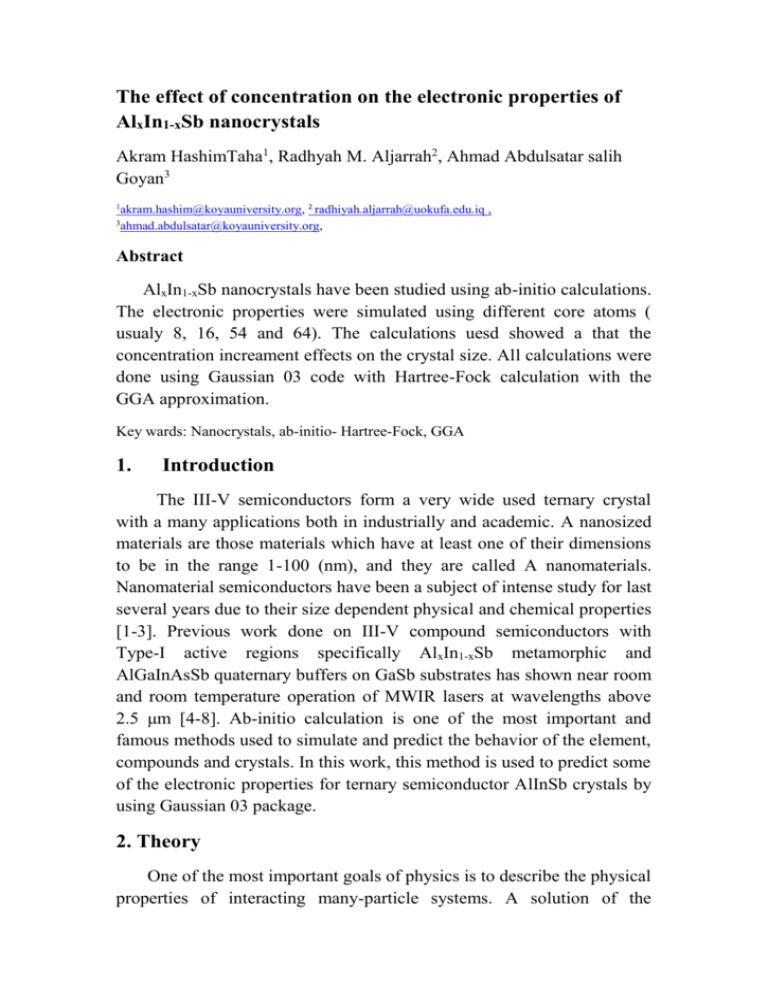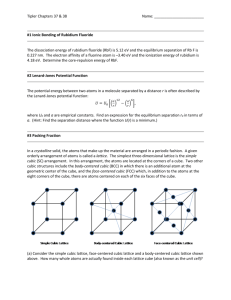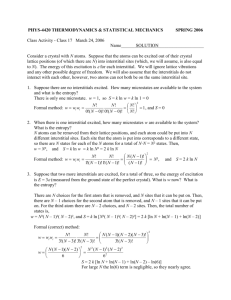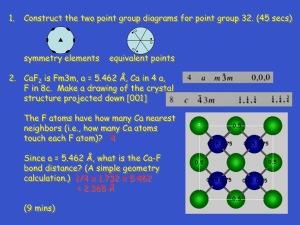Table (1) represents the values of lattice constant for many
advertisement

The effect of concentration on the electronic properties of AlxIn1-xSb nanocrystals Akram HashimTaha1, Radhyah M. Aljarrah2, Ahmad Abdulsatar salih Goyan3 1 3 akram.hashim@koyauniversity.org, 2 radhiyah.aljarrah@uokufa.edu.iq , ahmad.abdulsatar@koyauniversity.org, Abstract AlxIn1-xSb nanocrystals have been studied using ab-initio calculations. The electronic properties were simulated using different core atoms ( usualy 8, 16, 54 and 64). The calculations uesd showed a that the concentration increament effects on the crystal size. All calculations were done using Gaussian 03 code with Hartree-Fock calculation with the GGA approximation. Key wards: Nanocrystals, ab-initio- Hartree-Fock, GGA 1. Introduction The III-V semiconductors form a very wide used ternary crystal with a many applications both in industrially and academic. A nanosized materials are those materials which have at least one of their dimensions to be in the range 1-100 (nm), and they are called A nanomaterials. Nanomaterial semiconductors have been a subject of intense study for last several years due to their size dependent physical and chemical properties [1-3]. Previous work done on III-V compound semiconductors with Type-I active regions specifically AlxIn1-xSb metamorphic and AlGaInAsSb quaternary buffers on GaSb substrates has shown near room and room temperature operation of MWIR lasers at wavelengths above 2.5 μm [4-8]. Ab-initio calculation is one of the most important and famous methods used to simulate and predict the behavior of the element, compounds and crystals. In this work, this method is used to predict some of the electronic properties for ternary semiconductor AlInSb crystals by using Gaussian 03 package. 2. Theory One of the most important goals of physics is to describe the physical properties of interacting many-particle systems. A solution of the Schrödinger equation yields the electron state and their characteristics for a given arrangement of the atoms [9]. The Hartree-Fock method coupled with large unit cell (LUC) and applying generalized gradient approximation (GGA) level. For n electrons systems the Schrödinger equation is given by Hˆ ( R1 , R2 , ....RN , r1 , r2 , ......., rn ) E ( R1 , R2 , ....RN , r1 , r2 , ......., rn ) (1) The non-relativistic Hamiltonian for a system consisting n electrons and N nuclei is given by (all equations are expressed in atomic units): 1 N 1 H 2I 2 I 2 n n N i i I i2 n ZI N ZI ZJ 1 rIi I J rIJ i j rij (2) where the lower-case indexes are the electron and the upper-case indexes are the nuclei. r is a distance between the objects specified by the subscripts. Born-Oppenhiemer applied an approximation by presuming that the nuclear’s mass is very large relative to the mass of electrons then we can imagine the nucleus is at rest [10, 11]. Then the Hamiltonian will be reduced to 1 H el 2 n n N i i I i2 n ZI 1 rIi i j rij (3) Then the expectation value of Hamiltonian operator due to the HartreeFock representation is given by: N N 1 E HF HF Hˆ HF H i ( J ij K ij ) 2 i , j 1 i 1 (4) Where H i defines the contribution due to the kinetic energy and the electron-nucleus attraction. The unrestricted Hartree-Fock is based upon the use of a single determinant total wavefunction in which orbitals of the same n, l, and ml values but different ms. values are regarded as being independent [12]. This method is the most common molecular orbitals method for open shell molecules where the number of electrons of each spin is not equal. It is an extremely convenient method because it is a very natural extension of the conventional Hartree-Fock method, and the many-electron wave function is written in the form of a single determinant so that calculations are relatively easy. 1. Results and discussion Gaussian 03 is one of the most powerful software, that deals with large numbers of atoms. The lattice constant optimization of 8, 16, 54 and 64 core atoms LUC has been tested in order to find the best value for lattice constant. They show a reduction of the total energy in the core part versus increment in the lattice constant till it reaches the equilibrium lattice constant (the distant where the attraction and the repulsion forces are equal at which the total energy has minimum value). The attractive force is the dominant at large distances between atoms hence increasing the total energy fig. (1). The fitting of the potential curve with polynomial equation gives the equilibrium lattice constant which is shown at the bottom of the total energy curve. Table (1) Shows different Indium concentrations in the Al1-xInxSb alloy with the corresponding lattice constants. The lattice constant’s value can be calculated from [13] A(alloy)= x(a1)+(1-x)a2 (5) Where x is the concentration The lattice constant is the basic parameter characterizing the crystal. According to equation (5) the lattice constants for Al25In75Sb, Al50In50Sb, and Al75In25Sb appears to be 0.62255, 0.63145, and 0.64045 nm respectively. Comparing with the table these values are in good agreement with the values simulated in this work and is obeying the Vegard’s law, i.e the change of the lattice constant is proportional to the concentration of the dopant [14]. 0.58 0.6 Lattice Constant (nm) 0.62 0.64 0.66 Total energy(eV) -1151137 -1151137 -1151137 -1151137 -1151137 -1151138 -1151138 -1151138 Figure 1. Shows the optimization of the lattice constant at minimum energy for Al25In75Sb 8 core atoms nanocrystals. Lattice Constant (nm) 8 core 16core atoms atoms Al25In75Sb 0.630 Al50In50Sb 0.624 Al75In25Sb 0.618 0.627 0.622 0.613 54core atoms 64core atoms 0.616 0.612 0.605 0.615 0.610 0.605 Table (1) represents the values of lattice constant for many concentrations of In in the Al1-xInxSb alloy. The total energy decreases with core number increment which means more energy needed to overcome the binding energy (see Fig. 2). Total energy(eV) 0 0 -1000000 -2000000 -3000000 -4000000 -5000000 -6000000 -7000000 -8000000 -9000000 -10000000 10 20 No. of core atoms 30 40 50 60 70 Al25In75Sb Al50In50Sb Al75In25Sb Fig. 2. The total energy as a function of number of core atoms for In concentrations (0.25, 0.5 and 0.75). The relationship between the cohesive energy and the number of core atoms is shown in figure (3). The cohesive energy has been calculated By the following equation [15] Ecoh. ET E Free E0 n ( 6) 0 10 20 No. of core atoms 30 40 50 60 70 Cohesive energy(eV) -6.6 -6.8 -7 -7.2 -7.4 -7.6 Al25In75Sb Al50In50Sb Al75In25Sb -7.8 Fig. 3 The cohesive energy vs the number of core atoms for Al 1-xInxSb nanocrystals for three concentrations of In 0.25, 0.5 and 0.75. Finally varying the Indium concentration in the AlxIn1-xSb crystal causes in an decreament in the crystal dimensions see fig. 4. 0.66 Lattice constant(nm) 0.65 0.64 0.63 0.62 0.61 0.6 0.59 8 Core atoms 16 Core atoms 64 Core atoms Experimental value 54Core atoms 0.58 0 0.25 0.5 Al Concentration in the AlInSb 0.75 1 Fig. 4 the concentration of In in the AlxIn1-xSb nanocrystals as a function of lattice constant (for x= 0.25, 0.5, and 0.75) References [1] R. Rosseti, S. Nakahara, and L. E. Brus, ” Quantum size effects in the redox potentials, resonance Raman spectra, and electronic spectra of CdS crystallites in aqueous solution ” J. Chem. Phys. 79, 1086 (1983) [2] Norman Henon, Y ing Wang, and Hellmut Eckert, “Synthesis and Characterization of Surface-Capped, Size- Quantized CdS Clusters. Chemical Control of Cluster Size” J. Am. Chem. Soc. 112, pp1322-1326 (1990) [3] J. Woltersdorf, A. S. Nepijko and E Pipple, “The Synthesis of Nano Hybrid CNTs/TiO2 Materials” Surf. Sci. 106, 64 (1981). [4] T. Hosoda, G. Kipshidze, L. Shterengas, and G. Belenky, "Diode lasers emitting near 3.44 mu m in continuous-wave regime at 300K," Electronics Letters, vol. 46, pp. 1455-1456, OCT 14 2010 2010. [5] T. Hosoda, G. Kipshidze, G. Tsvid, L. Shterengas, and G. Belenky, "Type-I GaSb-Based Laser Diodes Operating in 3.1-to 3.3-mu m Wavelength Range," Ieee Photonics Technology Letters, vol. 22, pp. 718720, MAY 15 2010 2010. [6] J. Kim, L. Shterengas, R. Martinelli, and G. Belenky, "High-power room temperature continuous wave operation of 2.7 and 2.8 mu m In(Al)GaAsSb/GaSb diode lasers," Applied Physics Letters, vol. 83, pp. 1926-1928, SEP 8 2003 2003. [7] L. Shterengas, G. Belenky, G. Kipshidze, and T. Hosoda, "Room temperature operated 3.1 mu m type-I GaSb-based diode lasers with 80 mW continuous-wave output power," Applied Physics Letters, vol. 92, pp. -, APR 28 2008 2008. [8] P. Hill, N. Weisse-Bernstein, L. Dawson, P. Dowd, and S. Krishna, "Activation energies for Te and Be in metamorphically grown AlSb and InxAl1-xSb layers," Applied Physics Letters, vol. 87, pp. -, AUG 29 2005 2005. [9] David J. Griffiths, "Introduction to quantum mechanics", Prentice Hall (2005) [10] M. Born, J. R. Oppenheimer, “On the Quantum theory of molecules”, Annalen der Physik, 389, 20 (1927). [11] M. Born and K. Huang, Dynamical Theory of Crystal Lattices, 1954 (Oxford University Press, New York), Chapter IV [12] Pratt G. W., “Unrestricted Hartree-Fock Method”, Phys. Rev. Vol. 102, issue 5, pp 1303-1307(1956). [13] Sadao Adachi, “Properties of Semiconductor Alloys: Group-IV, IIIV and II-VI Semiconductors”, WILEY. [14] Yen-Kuang Kuo, Bo-Ting Liou, Sheng-Horng Yen, Han-Yi Chu, “egard’s law deviation in lattice constant and band gap bowing parameter of zincblende InxGa1-xN”,Optics commun. 237,Issue(4-6) (2004) [15] C. Allen, “Astrophysical quantities”, The Athlone Press (1973)








![paper_ed25_9[^]](http://s3.studylib.net/store/data/007452614_1-aa067b97bc948f9c913341c71de07923-300x300.png)